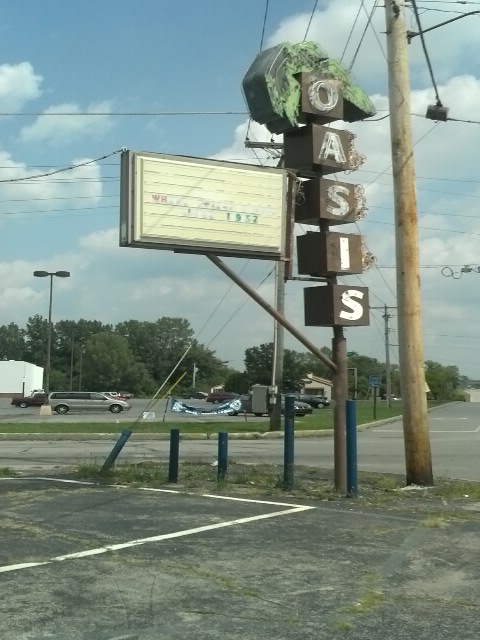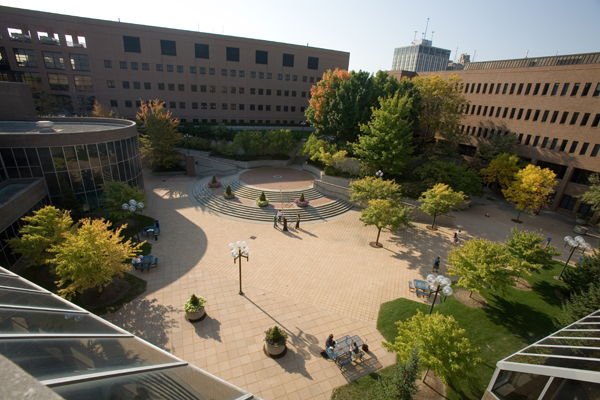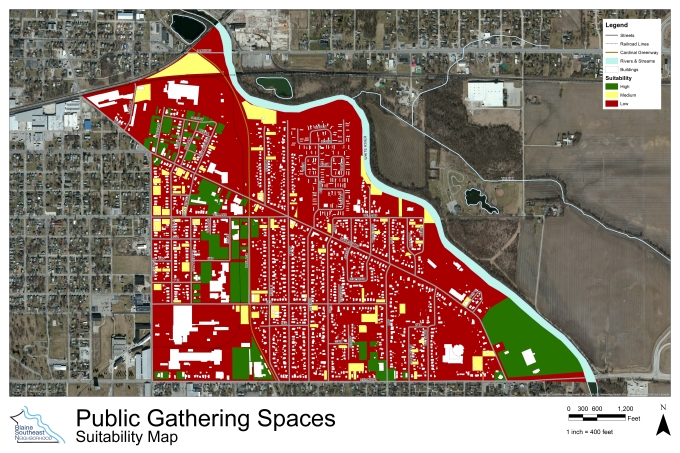The initiative “Creating Public Gathering Spaces” relates to the MAP Initiative 4, “Creating Attractive and Desirable Spaces” because both of these initiatives focus on creating places “in which people want to live, work, play, and visit” (MAP 29). This initiative applies to the Blaine-Southeast Neighborhood because public gathering spaces create opportunities to build community at the human level, while also improving neighborhood aesthetics and the local economy. According to the neighborhood survey, about 45% of the respondents mentioned that they knew only a few or none of their neighbors. When residents have the chance to interact with one another out in the community, relationships can be made and quality of life enhanced.
Why this is important
This initiative was conceived at the first public meeting with the Blaine-Southeast Neighborhood Association on Tuesday, September 9, 2014. During an activity where residents listed assets and improvement areas in the community, one resident pointed out that the neighborhood would benefit from adding public gathering spaces. Urban planning students from Ball State University organized these comments into five categories, and this initiative was included in the economic development goal.
Public gathering spaces are the areas in a neighborhood where residents can enjoy and truly appreciate the community in which they live. Big cities and small towns alike all began with public spaces that were at the heart of all activity in the community. Town squares used to be the social and economic hubs of towns all across the country. Today, local governments and community organizations have been forced to think of creative ways to sustain and expand the economy in a community. One way of doing this is by investing in attractive public spaces. In this sense, a public space can be as small as an outside seating area near a store/restaurant or as large as an urban plaza. Placemaking, the process of actively involving the general public in developing public spaces, is being used more and more in the field of economic development as a powerful driver for the local economy.
The quality of life in Blaine-Southeast can be improved by creating vibrant public spaces that capitalize on the neighborhood’s assets as a quiet, residential community. There are many underutilized spaces adjacent to the existing businesses spread across Blaine-Southeast. These areas include large parking areas, inactive street corners (Figure 1), and vacant or blighted lots. By re-imagining these spaces into public gathering areas, residents would have a higher incentive to support local business growth. Developing public spaces in Blaine-Southeast could also provide opportunities for attracting and developing unique businesses that employ residents, bring in outside tax money, and build upon the neighborhood’s culture.

Figure 1 – An underutilized street corner at the intersection of Burlington and Memorial. Photo: Alexis Busselberg.
What this will involve
For this initiative to take place, the Blaine-Southeast Neighborhood Association would first have to establish a Public Spaces Subcommittee. The subcommittee would be responsible for organizing events and engaging residents in the placemaking planning process. To begin planning for new public spaces in the neighborhood, the neighborhood association could host a meeting in which residents and stakeholders identify the 10 most important places in Blaine-Southeast. These places could be existing areas that the neighborhood is proud of, or they could be areas in need of improvement. For economic development purposes, these target areas could be focused around existing businesses in the neighborhood or in areas where public spaces might promote future business investment.
The next step would be for the public spaces subcommittee to organize a “dreamwalk” around the 10 locations specified in the previous step. A dreamwalk is where the public is invited to travel around to the potential sites in a neighborhood and imagine how public spaces could improve them. This event would be a great way to advertise and build public support for the project, while also receiving valuable feedback on the potential of different sites in the neighborhood.
Data from the dreamwalk should then be collected and used in a brainstorming/conceptual design session organized by the BSNA. The College of Architecture and Planning at Ball State could be an invaluable partner in this part of the process. Students and faculty could act as facilitators in the meeting, while also helping community members to develop realistic concepts for potential public spaces. These concepts should be accompanied by achievable goals, such as providing an outdoor place for retail shoppers to gather, or connecting different businesses with a shared public space, etc. This meeting should also establish levels of priority for the different concepts being explored. The most achievable and realistic concepts should be established as high priorities over larger, more long-term projects. By focusing on smaller, less expensive projects, momentum can eventually be built for projects with a larger impact.
After developing preliminary concept ideas, different funding sources should be explored. This step is crucial in ensuring that placemaking concepts and goals become reality. A great local asset in the community is the Community Foundation of Muncie and Delaware County. The Community Foundation offers a Quarterly Competitive Grant for projects in a variety of categories, including arts and culture, economic development, and community development which relate specifically to this initiative. To apply, the neighborhood association would have to partner with a local non-profit listed as a 501(c)(3) in Muncie and fill out the application on the Community Foundation’s website. The due dates for the quarterly grant cycles in 2015 are: January 9, April 10, July 10, and October 9. Two other local organizations that can offer funding resources are the Ball Brothers Foundation and the Muncie Department of Community Development. The Ball Brothers Foundation also offers competitive grants to Muncie-based community groups. Similar to the Community Foundation, organizations must have tax-exempt status to apply. The foundation has grant cycles ending on April 1 and July 15. The Department of Community Development offers Community Development Block Grants (CDBG) and the Neighborhood Stabilization Program (NSP) on a competitive basis to help with community projects. All of these organizations are great assets to the Muncie community and could offer a variety of funding sources for placemaking efforts in Blaine-Southeast.

Figure 2 –A concept illustration of a new public gathering space at the corner of Memorial Drive and May Avenue. Artist: Bryant Niehoff.
Contact information for funding/assistance sources
College of Architecture and Planning
Architecture Building, Room 104
Ball State University, Muncie, IN 47306
Phone: (765) 285-5859
Fax: (765) 285-3726
Contact: Judy Wand, College Programs Assistant
Email: cap@bsu.edu
Website: http://cms.bsu.edu/academics/collegesanddepartments/cap/contactus
The Community Foundation of Muncie and Delaware County
201 E. Jackson St. (First Floor)
P.O. Box 807 Muncie, IN 47308-0807
Phone: (765) 747-7181
Fax: (765) 747-7770
Contact: Ms. Cheryl Decker
Email: cdecker@cfmdin.org
Website: http://www.cfmdin.org/
The Ball Brothers Foundation
222 S. Mulberry St., Muncie, IN 47305
P.O. Box 1408, Muncie, IN 47308
Phone: (765) 741-5500
Contact: Donna Munchel, Grant Process Manager
Email: info@ballfdn.org
Website: http://www.ballfdn.org/
Department of Community Development
300 N. High St. City Hall
Muncie, IN 47305-1639
Phone: (765) 747-4825
Fax: (765) 747-4898
Contact: Ms. Terry Bailey, Director
Email: tbailey@cityofmuncie.com
Website: http://www.cityofmuncie.com/muncie-community-development.htm
Suitability analysis
Creating public gathering spaces in Blaine-Southeast pertains to areas in the entire neighborhood. The Public Gathering Spaces Suitability Map, as seen in Figure 3, labels areas with high, medium, and low suitability for starting the placemaking process. Parcels in green specify the best locations for developing public spaces. These areas are commercial or vacant parcels within close proximity of an existing business in the community. Many of these existing businesses have large, underutilized parking lots that could be reduced in size to include public spaces as small-scale attractions. Areas in green are also the most suitable because they align with the Neighborhood Business District Suitability Map’s high and medium suitability areas. When coordinated together, these two economic development initiatives could be mutually beneficial. Parcels in yellow are vacant and commercial properties separated from the existing business clusters in the neighborhood. Placemaking initiatives could work in these areas, but the likelihood that they would inspire future development is much lower than that of the most suitable areas. The remaining parcels in Blaine-Southeast have low suitability for developing public spaces and are categorized in red. These areas are not suitable for public gathering spaces because they are primarily residential, industrial, and other special land uses.
Summary of relevant case studies
Case Study: Placemaking in Flint, MI
The city of Flint, Michigan has a story similar to that of many other American cities in the Midwest: that of economic decline. Flint was once an economic hub for the automobile industry, but after many of these factories, including General Motors, relocated to other regions, the city fell into a serious state of disrepair. Attempts at improving the local economy have been made in recent years, but most of them have failed due to the city devoting all of its resources to large, stand-alone projects that eventually fall through, leaving the city with nothing to fall back on. With continued failure from these costly development projects, the City of Flint decided to try something new. The city decided to focus economic development efforts inward by improving its public spaces. Local leaders have been patient with the process and are involving the public in every step—the complete opposite approach than what they tried with the failed large-scale projects.
The city has been focusing on creating gathering places in three key areas: the Flint Farmer’s Market, Riverbank Park, and the downtown UM-Flint Campus (University of Michigan). The placemaking process for these spaces, and many others in the city, began in 2006 when the Project for Public Spaces (PPS) came in as a consultant. PPS is a world-renowned non-profit planning organization that specializes in developing long-term public spaces that enhance the quality of place. In 2006 PPS led placemaking workshops with city leaders, residents, businesses, non-profits, and other stakeholders who believed in taking Flint to its fullest potential. The group from PPS led community members through the process of defining places in their community that they care about and wish to capitalize on. The main focus was on how these places could be improved and better connected to other important areas of the city.
To turn these dreams into a reality, community leaders started forming relationships with different entities in the city. These included private donors, local universities, and government organizations, such as the Downtown Redevelopment Authority and the Uptown Reinvestment Corp. These organizations offered a variety of generous funding sources to invest in the design and construction of new gathering places in the city. A group of young adults calling themselves the Flint Club were at the forefront of this movement. This group is comprised of young adults who grew up in the city, moved away, and eventually came back to make a difference in improving the quality of life. Many of these Flint activists moved back to capitalize on economic opportunities in the city and open small businesses. As a result, Flint has continued to see great outcomes from its initial investment in the three public spaces, and the placemaking movement is beginning to spread to other important areas of the city.

Figure 4 – McKinnon Plaza at the University of Michigan Flint Campus. Source.
Additional websites of interest
Characteristics and Guidelines of Great Public Spaces
– The American Planning Association’s guidelines for creating great public spaces.
A Guide to Neighborhood Placemaking in Chicago
– Compiled by the Project for Public Spaces with specific steps on implementing placemaking goals at the neighborhood level.

